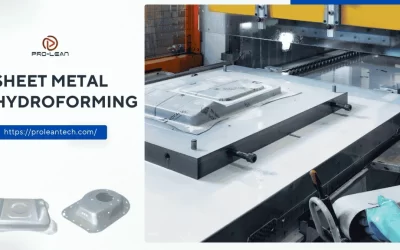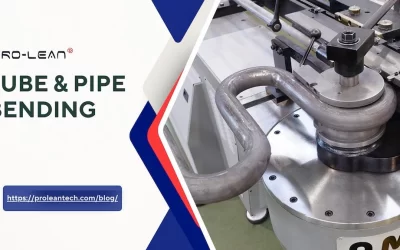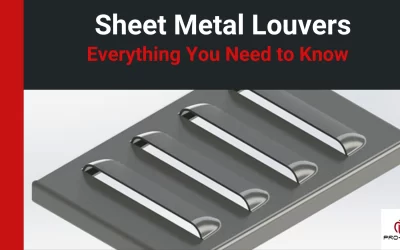
Metal like aluminum, steel, stainless steel, copper, brass, and titanium are popular in manufacturing for various metal parts. Sheet fabrication techniques, CNC machining, drilling, EDM, metal 3D printing, and other similar technologies are used to produce custom metal parts, prototypes, and end-use products. Here, custom parts refer to designs of parts to solve some specific problem or functionality, instead of standard industrial manufacturing.
The use of custom parts can be seen across the industrial manufacturing sectors, automotive, industrial equipment, electronics, aerospace, consumer goods, etc. This article will discuss various methods for custom metal parts manufacturing, commonly used materials, and application scope.
Let’s start it!
What are the Custom Metal Parts?
A custom metal part refers to the conversion of an engineering design (concept) into physical parts that can perform the desired functionality. It might involve one or more machining or fabrication techniques cutting, forming, machining, extrusion, etc.
The custom designs often include multiple geometrical features, from undercuts to bends. Meanwhile, the design must consider the Desing For Manufacturability (DFM) factors. Additionally, you also need to ensure the tooling efficiency and part for desired shapes. It can be done by simulating the process in computer software to analyze the possible challenges and hw can be tackled them.
Some examples of custom metal parts are; aircraft brackets, heat exchanger plates, custom heat sinks, hydraulic manifolds, etc.
Try Prolean Now!
Six Methods of Custom Metal Parts Manufacturing?
The methods below can make custom steel parts, aluminum, brass, and many other metals or alloys;
CNC Miling
CNC milling uses diverse cutters and tools to produce complex metal parts with intricate features and tight precision. It is suitable for almost all metals with tool coating consideration, including hard alloys. Consequently, custom programs can be run to dictate the cutter’s movement through the spindle.
The higher axes( 4, 5, or 6) CNC milling machines can convert highly customized designs, but it also costs more than regular milling. Additionally, the higher axes machining also makes the parts accurate and leaves a smooth machined surface.
CNC Turning
This method mainly deals with custom metal parts with cylindrical geometries (axially symmetric shapes). It involves revolving the work at the spindle with high RPM and removing the material through cutters attached to the tool post. The tool fed the rotating works to remove the material layers in the form of small chips.
CNC turning is used to machine shafts, screws, pins, gears, bolts, hubs, coupling, and many more mechanical items.
Aluminum Extrusion
First, a custom die extrusion die is made with materials like high-strength steel alloys in this method. The die consists open cavity where heated metals are pushed from one end and, the die shapes the metal profile leaving another end. The extruded custom aluminum parts might need cutting, trimming, or other minor pot-processing.
The extrusion dies are reusable for several thousand cycles, which makes them suitable for consistent parts in high volumes. Some examples of extruded aluminum parts are; tubing, pipe, electrical busbars, automotive roof rails, custom door frames, etc.
Sheet Metal Forming

Custom sheet metal part
It involves converting raw sheet metals into components of some product or end-use products using different Sheet metal fabrication techniques, such as metal stamping, bending, laser cutting, punching deep drawing, etc.
| Technique | Process | Examples of Custom Parts |
| Metal Stamping | A punch presses the sheet into a custom-shaped stamping die. | Automotive panels, electronic components |
| Bending | It deforms metal sheets into angles or curves. | Brackets, enclosures, structural frames |
| Laser Cutting | A laser beam precisely cuts or shapes these sheets. | Custom parts, signage, intricate designs |
| Punching | It creates holes in metal sheets using punch-and-die setups. | Enclosures, housing, ventilation grilles |
| Deep Drawing | Stretches metal into a deep and hollow shape using a punch. | Cans, kitchen sinks, automotive fuel tanks |
Metal 3D printing

Custom 3D print parts
Metal 3D printing can build custom metal parts by adding layer by layer of raw material in a printing bed. The simple tooling and speed of metal 3D printing are beneficial for rapid prototypes of custom parts.
| Method | Process | Applications of Custom parts |
| Selective Laser Melting (SLM) | A laser selectively melts metal powder layer by layer and builds the desired parts. | Aircraft parts, medical implants, molds, etc. |
| Electron Beam Melting (EBM) | An electron beam to melt metal powder in a vacuum environment fuses the material into a designed shape, | Custom turbine blades, and orthopedic implants. |
| Binder Jetting | A binder is applied to layers of metal powder and then sintered in a furnace to solidify the part. | Complex and lightweight structures, low-cost prototypes, etc. |
Metal Casting

Custom die-cast part
These methods are relatively costlier due to the high initial investment for molds or dies unless you want the large custom metal parts manufacturing batches. Die casting, sand casting, investment casting, and other similar techniques can be used based on the raw material properties. For example, die casting is popular for non-ferrous metal alloys, aluminum, magnesium, etc. On the other sand casting is favorable to ferrous materials.
How to Choose the Right Method for Custom Metal Parts?
As we have discussed several methods of custom metal parts manufacturing, you might be thinking about which one to choose for optimal results and saving costs. It depends on different factors; which metal or alloy you are using, the intended application, design complexity, production volume, etc.
Consider Raw Material Type
First, the metal you are processing must be highly compatible with the manufacturing methods. Extrusion is ideal for custom aluminum parts, whereas sheet metal forming is compatible with a wider range of sheet metals. Metal 3D printing is more suited for rapid prototypes of custom metal components or products. Steel custom parts can be made with machining and fabrication techniques.
Design Flexibility and Customization
According to the complexity of your design and the requirement of design iteration, choose the method that crafts intricate details and does not cost much for the design changes. Typically, die or mold tooling-related methods cost more in case of any slight alteration in part design. On the other hand, CNC machining, or fabrication techniques are highly adaptable with changes in design features or modifications.
Production Cost
Cost is another factor, some methods are expensive and some are cheaper, based on their capabilities and production volume. Additionally, if the manufacturers have in-house die or tooling manufacturing facilities, it also reduces the cost.
Desired Precision
Compare the precision capabilities of the available technologies with your requirements. CNC, 3D printing, and extrusion can achieve relatively higher precision.
The Applications of Custom Metal Parts
Custom metal parts are everywhere, from electronic enclosures to custom medical implants and defense items. Typically, precision and performance-sensitive designs require custom manufacturing processes.

Custom metal parts application examples
The following are some examples of custom metal parts;
- Aircraft fuse glass brackets, turbine blades, and landing gear parts
- Satellite structural frame
- Vehicle transmission housing, brake calipers, and exhaust system
- Stainless steel surgical instruments
- Titanium bone screws and dental implants
- Hear, sinks, custom enclosures, and EMI shielding covers
- Tank armor plating and casing for missile guiding system
- Valve bodies for high-pressure systems
- HVAC Ductwork
- Marine equipment parts
- Antenna mounts for telecommunication equipment
- Conveyor belts
Try Prolean Now!
Considerations for Purchasing Online Custom Metal Parts
Ordering the custom metal parts online is more critical than purchasing the standard manufactured parts. You need to count different factors, from sending your custom design to quality confirmation before delivery.
- Capabilities of Manufacturer
Does the manufacturer have the equipment and professionals to handle your custom metal part design? Especially, which manufacturing method you need and whether the manufacturers have related machinery and tooling or not.
- Request the Quotation
You can send your design and request pricing quotes from different manufacturers. Then, analyze the cost structures and offerings.
- Lead Time
Check the manufacturer’s production speed and delivery time to see if they match your project timeline.
- The Technicality of Desing Changes and Cost
Can manufacturers adjust the manufacturing process for any changes or modifications in design, how much does that cost, and expected delivery delay?
- Tooling Facility
If a manufacturer produces the die, molds, or other related custom tooling in their in-house factory, it significantly reduces the production time and cost. So, check whether they have an in-house tool production facility or not.
If you need custom metal parts, ProleanTech can be a reliable option. We are a China-based manufacturer with 50+ metal and alloy options for custom parts. Our In-house tool manufacturing with CNC, EDM, laser, and other technology makes the foundation for customization according to your design. Then, advanced equipment for custom parts at our factory creates parts used across the industries. If you want to know our price structure and capabilities, you can get a quote here.
Conclusion
Custom metal parts serve unique functionality or maintain performance in specific conditions. CNC machining, sheet metal forming, extrusion, and other methods are available to choose based on your work material type and requirements. The custom metal parts are used in the automotive, electronics, agriculture, aerospace, and many other industries.




0 Comments